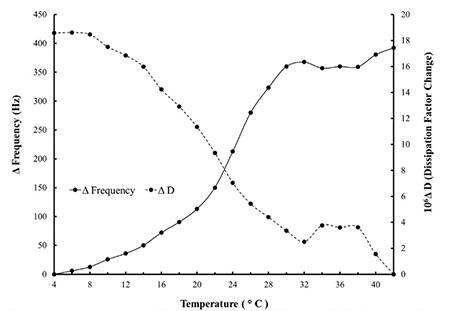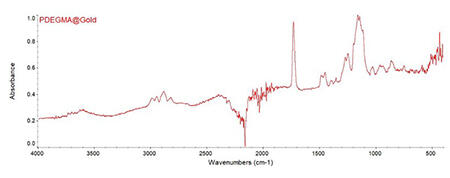Background

Figure 1: QCM-I assessment of frequency change (solid line) and dissipation factor change (dotted line) for PDEGMA coating on gold as a function of temperature change.
The purpose of the project was to develop a thermoreversible surface coating that can allow continuous monitoring and separation of immune cells. Immune cells are the target biological due to their importance in CAR-T therapy, an FDA approved, commercially available cell and gene therapy for cancer. The coating would reduce costs and improve efficiency over currently used methods.
Approach
The approach involved using “grafted to” and “grafted from” polymer synthesis approaches to first fabricate a thermoreversible surface coating with a lower critical solution temperature (LCST) of ca 30°C. More specifically, the coating will dehydrate/shrink and become hydrophobic at temperatures above LCST, and hydrate/swell and become hydrophilic below LCST. The strategy was to expose a binding antibody above LCST to bind target Jurkat T cells and hide the antibody below LCST to release bound Jurkat T cells. Jurkat T cells are an immortalized T-cell line used for studying T-cell biology. We successfully fabricated a PDEGMA (poly(di(ethylene glycol) methyl ether methacrylate)) surface coating with an LCST of ca 30°C using a “grafted from” atomic transfer radical polymerization (ATRP) reaction. Quartz crystal microbalance sensor with impedance (QCM-I) shows a significant increase of sensor frequency and decrease in dissipation factor as temperature increases from 22->26°C, since the adsorbed polymer changes conformation from a flexible hydrophilic, water swollen state to a more condensed, stiff hydrophobic state. The change then begins to level out at 30°C where the polymer has released close to the maximum amount of water. Fourier transform infra-red (FTIR) spectroscopy also confirmed the presence of chemical moieties characteristic of the PDEGMA layer that was fabricated on the gold coated sensor surface.
Accomplishments

Figure 2: FTIR of PDEGMA fabricated on gold surface.
We have fabricated the thermoreversible polymer that will be used for exposing and hiding the antibody that binds target Jurkat cells at a temperature of ca 30°C that supports the cell targeting and cell removal strategy outlined above.

